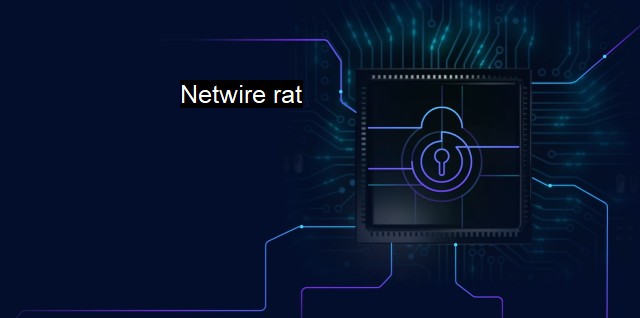What is Netwire rat?
The Insidious Netwire RAT: A Comprehensive Overview of its Tools, Techniques and Threats in Cybersecurity
The term "Netwire RAT" might sound foreign to those unfamiliar with cybersecurity terminologies, but it is a crucial component of the cybersecurity field. It is a term of great significance in the digital world, especially amongst those who work in data protection, computer security, and information system analysis.To further dissect the term, Netwire RAT is an advanced Remote Access Trojan (or RAT) aimed at infiltrating a target's computer system clandestinely. This Trojan-type formula intend rescind personal information for malevolent uses. The term RAT is an acronym that stands for "remote administration tools". Quite literally, these are software - typically malicious - which allow a third party to gain controlled access of another system without the owner's knowledge or permission. In contrast, Netwire is a term derived from the high-profile and advanced nature of the relative software.
Netwire RAT has been active for more than a decade and has proven to be a grave threat to cybersecurity. Its original function was to manage customer data, but it has evolved to serve detrimental objectives. The complex code behind this RAT allows it to break into various operating systems including Windows, macOS, Linux, and Solaris. Its multi-layered and sophisticated functionality enables it to bypass even the most secure antivirus systems and allows it to remotely access, monitor, and manipulate systems without user's consent.
There are cases where Netwire RAT is employed on legitimate platforms. exploiters commonly leverage it to infiltrate personal, corporate, and governmental networks, leaving catastrophic repercussions in its wake. Its methods of dispersion include spear phishing emails containing malicious software, fake application downloads, malicious document files, or through compromised websites.
In terms of operation, once the Netwire RAT has found its way into either the user’s email or computer, it operates silently in the background. It initiates keylogging facilities, thus tracking the victim's keystroking habits, collating valuable data such as login credentials, credit card details, and other confidential information which can then be utilized for ulterior motives including identity theft, monetary fraud, unauthorized data access, and even extortion in the form of ransomware.
In the infinite realm of cybersecurity, Netwire RAT stands out only for the threat it poses. Organizations around the globe invest substantial resources for its detection and elimination, tightening their cybersecurity walls. Numerous optimal performing antivirus programs have incorporated strategies to counteract malicious invasions by Netwire RAT into their protective regimes.
To safeguard against potential Netwire RAT infestations, cybersecurity best-practices suggest using strong, hard-to-decipher passwords, ensuring devices always use the most advanced vulnerability patches and antivirus programs, discouraging downloading suspicious email links, and keeping a careful eye on unexpected system behavior.
Despite these protective measures, it is essential to remember how resourceful the damaging code concealed behind Netwire RAT truly is. Outmaneuvering antivirus programs, transcending standard firewalls, and eventually gaining detailed access to one’s life, the omnipresent risk posed by software like Netwire RAT embodies the pivotal need for consistent cyber-vigilance and stringent malware protection in our increasingly digital world.
While the digital term “Netwire RAT” may initially come off as complex and ambiguous, the power and threat it portrays within cybersecurity domains aren't vague by any means. It emphasizes the paramount importance of good cyber hygiene, robust cybersecurity infrastructure, and protective measure upkeep. The threats from such softwares like Netwire RAT remain an abiding nightmare, urging us consistently not to underestimate the necessity of cybersecurity—not today, not ever.

Netwire rat FAQs
What is NetWire RAT?
NetWire RAT (Remote Access Trojan) is a type of malware that hackers use to gain unauthorized access to a victim's computer, steal data, and take control of the machine. It allows cybercriminals to remote control the infected computer and execute various malicious actions.How is NetWire RAT typically distributed?
NetWire RAT spreads through various methods, including spam emails, exploit kits, malicious links, and attachments. It is commonly disguised as an email attachment or bundled with legitimate-looking files or software.How can I protect my computer from NetWire RAT?
To protect your computer from NetWire RAT, it is recommended to keep your operating system, antivirus software, and other software programs up to date. Make sure to download software only from trusted sources, avoid opening suspicious attachments or links, and be wary of unsolicited emails or messages.What should I do if my computer is infected with NetWire RAT?
If you suspect that your computer is infected with NetWire RAT, immediately disconnect it from the internet and run a full virus scan with your antivirus software. It is also recommended to change all your passwords and monitor your accounts for any unauthorized activity. Consider seeking help from a cybersecurity professional to remove the malware and prevent further attacks.| | A | | | B | | | C | | | D | | | E | | | F | | | G | | | H | | | I | | | J | | | K | | | L | | | M | |
| | N | | | O | | | P | | | Q | | | R | | | S | | | T | | | U | | | V | | | W | | | X | | | Y | | | Z | |
| | 1 | | | 2 | | | 3 | | | 4 | | | 7 | | | 8 | | |||||||